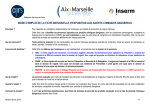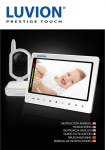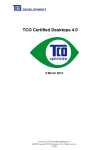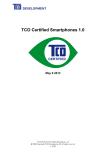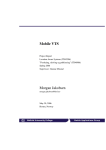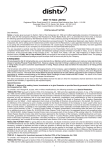Download Safety routines for work involving potentially hazardous chemicals
Transcript
Safety routines for work involving potentially hazardous chemicals and machinery Faculty of Science and Technology Approved by: Faculty Director and Meeting for Heads of Department 13.10.2014 Date: 23.05.2014 Table of contents 1. Background and objective .................................................................................................................. 2 3. Training ...................................................................................................................................................... 3 2. 4. 5. Responsibility .......................................................................................................................................... 2 General safety rules............................................................................................................................... 3 Safety rules – work involving hazardous chemicals ..................................................................... 4 Safety rules – work involving hazardous machinery ................................................................... 4 Other safety rules ................................................................................................................................... 4 Gas cylinders ................................................................................................................................................. 4 Chemical database ...................................................................................................................................... 5 6. Purchase and disposal of chemicals .................................................................................................... 5 Safety and personal protective equipment .................................................................................. 5 Clothing for work in laboratories or workshops............................................................................ 5 Safety glasses ................................................................................................................................................ 6 Gloves .............................................................................................................................................................. 6 Footwear in laboratories and workshops ......................................................................................... 6 Fume hoods ................................................................................................................................................... 7 Respirators .................................................................................................................................................... 7 Hearing protection ..................................................................................................................................... 7 7. Emergency equipment .............................................................................................................................. 7 Waste management ............................................................................................................................... 8 G:\HMS - JAO MHP\Routines for work in laboratories and workshops 8. Cleaning of premises where people engage in work involving hazardous chemicals and machinery .................................................................................................................................................. 9 9. 10. Chemical spills ......................................................................................................................................... 9 Appendices ........................................................................................................................................ 10 Appendix 1 – Approval of training at laboratory/workshop NT-fak .................................. 10 Appendix 2 – Hazard symbols and letter codes........................................................................... 11 Appendix 3 – Hazard signs ................................................................................................................... 13 Appendix 4 – Personal protective equipment signs .................................................................. 14 Appendix 5 – Emergency signs ........................................................................................................... 14 Appendix 8 – Examples of liquids in fire class 1, 2 and 3 ........................................................ 15 1. Background and objective These routines apply to all employees, students and guest researchers at the faculty. The objectives are to: • avoid damage/injury to people, property, equipment and the environment • be overarching guidelines for risk assessment and design of routines at the various laboratories/workshops where people engage in activities involving hazardous chemicals or machinery • ensure minimum requirements and uniform procedures at the faculty • give students and employees an understanding of and insight into HSE as an important part of the work in laboratories and workshops Use of personal protective equipment and safety routines must be adapted for each laboratory/workshop and the specific operations that are being performed. Risk assessments must be performed for all equipment, exercises/experiments and/or duties and any necessary safety measures must be implemented before the equipment, exercise/experiment and/or duty is adopted. 2. Responsibility • Heads of Department are responsible for ensuring that activities at the departments are performed in a safe and proper manner in accordance with the relevant Acts, regulations and procedures. • For each laboratory/workshop, a person shall be appointed who will have the overall responsibility for the laboratory/workshop in question. The name of the person responsible for the laboratory/workshop must be included on the room card and/or a notice displayed in the room. • Project managers, supervisors and course lecturers are responsible for the training and supervision of employees and students in their day-to-day work. • Each user (employee, student or guest researcher) must ensure that they perform their work in accordance with the stipulated guidelines and work routines. Each user has a responsibility to complete the necessary compulsory training, use of personal protective equipment and notification of nonconformity. 2 3. Training The training comprises three stages and must be documented in writing. 1. All employees (new appointments), Master’s degree students and guest researchers working in laboratories or participating fieldwork and/or seagoing expeditions must complete the university’s compulsory safety training, Safety in the laboratory and on land and sea expeditions. This covers the common courses and necessary/relevant special courses. 2. Prior to commencement of their work, all employees (new appointments), students and guest researchers working in a laboratory/workshop where people engage in activities involving hazardous chemicals or equipment shall receive necessary training about the specific laboratory/workshop and become familiar with it. 3. Prior to the commencement of new high-risk duties/experiments, all employees (new appointments), students and guest researchers shall receive training about these. Training at levels 2 and 3 shall include: • general safety and work routines • elements of risk and potential hazards at the specific laboratory/workshop and/or duties/exercises/experiments • step by step review of relevant duties/exercises/experiments • use of personal protective equipment • first aid and available first aid equipment • measures and equipment in the event of chemical spills (if relevant) • fire safety and evacuation routines • notification of injuries, accidents and nonconformity The training at levels 2 and 3 may occur in groups and shall be documented in writing (use the standard form, appendix 4). 4. General safety rules • Unauthorised persons are not permitted to enter premises where people engage in activities involving hazardous chemicals or machinery. • Doors to facilities where people engage in activities involving hazardous chemicals or machinery should always be locked when no one is present. • The consumption of food or drink is not permitted in facilities where people engage in activities involving hazardous chemicals or machinery. • Private experiments or work is not permitted. • Risk assessments must be performed of all experimental procedures and duties, and these must be approved by the supervisor. • Accidents and hazardous situations must be reported immediately to the supervisor, safety representative or manager. • Keep the laboratory/workshop tidy. • If it is necessary to perform work involving hazardous chemicals or machinery outside normal working hours, this must be agreed with the manager. Ensure that people are available and easy to contact in the event of an accident. 3 Safety rules – work involving hazardous chemicals The term hazardous chemical refers to chemicals that are classified and labelled in relation to health, safety and environment. • Read the materials safety data sheet and acquire information about the chemicals to be used, the risks associated with their use, necessary personal protective equipment and first aid. This information may be found in the chemical database ’CHESS’. NB: be aware of the hazard symbol on the label. • Any required personal protective equipment must be available and used. • Any unfamiliar chemical(s) should be considered toxic. • Wash your hands thoroughly after being in contact with chemicals or infected material. Use soap or other cleansing agent, not organic solvents. • Chemical residues must be collected up and delivered as hazardous waste. Chemicals that are corrosive or highly toxic should not be emptied into the sink. The same applies to organic liquids that are immiscible with water. Only small quantities of liquids that are miscible with water may be emptied into down the sink. • When using highly flammable chemicals, remember emergency preparedness and have the correct extinguishing agent available. • All bottles, flasks, glass containers etc. used to store chemicals must be labelled with content, date, name and any warning. • Unlabeled bottles, flasks, glass containers etc. containing unknown chemicals should be disposed of as hazardous waste. • Flammable chemicals must be stored in fireproof cabinets. Such cabinets must be labelled. • Toxic chemicals must be stored in suitably ventilated cabinets. Such cabinets must be labelled. • Take note of where the nearest fire extinguisher, emergency shower, eyewash station and first aid kit are located and how to use these. The water in the eye wash solution should be changed regularly. Safety rules – work involving hazardous machinery • Any laboratory/workshop containing hazardous machinery or equipment must have a sign on the entrance door stating this. • Following a risk assessment, any especially dangerous machinery/equipment must have an appropriate sign or labelling. • Use appropriate work clothes and personal protective equipment (see risk assessments) Refer also to specific risk assessments and safety routines that have been drawn up for some of the laboratories and workshops at the faculty of Science and Technology. 5. Other safety rules Gas cylinders • Gas cylinders should only be handled by people with the necessary expertise. • Gas cylinders must be transported using a special trolley. During transportation, the reduction valve should always be removed and the valve protective cap should be used (if any). • Gas cylinders must be fastened so they cannot fall. 4 • A warning sign for “compressed gas” must be on the door of the room. • If the gas cylinder(s) is removed, the warning sign should also be removed (important in the event of fire). Chemical database Refer to the Guidelines for the operation and maintenance of the chemical database at UiT. All laboratories/workshops where people engage in work involving hazardous chemicals and potentially hazardous chemicals must have a chemical database contact. A notice announcing the name of the chemical database contact must be displayed. The chemical database is a collection of material safety data sheets (MSDS) and other information about hazardous chemicals, radioactive materials and all hazardous biological materials in existence at the user sites/units. In addition to registration in electronic chemical database index (Chess), all user sites should have a folder containing a printed version of the MSDS. If an employee discovers that the chemical database is not updated or they procure new chemicals that are hazardous to one’s health and the environment, he/she shall notify the chemical database contact. The chemical database contact is responsible for updating Chess. Chemicals that are no longer in use should be disposed of and deleted from the chemical database. Link to the electronic chemical database “Chess” Purchase and disposal of chemicals Chemicals should always be purchased/ordered by fixed purchasing managers, who are obliged to inform chemical database contact about the purchase of any new chemicals. Chemicals should always be purchased in the smallest amounts possible. Prior to purchase, it is necessary to assess options for the disposal and management of any chemical residues. Chemicals that lack material safety data sheets (MSDS) or if the safety information is deficient should be disposed of. For new chemicals where safety information does not exist, it is necessary to prepare safety information that takes considers any potential hazards. An annual review of chemical storerooms should be conducted during which disposal procedures should be assessed. Please contact the specialist for chemical waste for assistance. 6. Safety and personal protective equipment The use of personal protective equipment will vary depending on the laboratory/workshop and the duties that are performed. Clothing for work in laboratories or workshops Clothing used in laboratories/workshops should prevent soiling/destruction of privately owned clothing, protect the user against hazardous chemicals and be of a type 5 that cannot be caught in machinery with moving parts or come into contact with chemicals. • An appropriate white laboratory coat must be worn for all work in laboratories involving hazardous chemicals. To prevent the spread of chemical spill, the user should normally remove the laboratory coat when they leave the laboratory. • When working with hazardous chemicals, the outermost layer of clothing must be quick and easy to take off. • Appropriate work clothes or a coat must be worn for all workshop activities involving hazardous machinery. • Garments without loose parts or strings that may be caught in moving parts or soiled by chemicals must be worn for all work involving hazardous chemicals or equipment. • Long hair must be satisfactorily restrained using headgear, a hair elastic or hairnet. Safety glasses • Safety glasses/face shield must be worn for all work involving hazardous chemicals. • Don’t use contact lenses. Use glasses (if necessary). The reason for this is that eye fluids can transport chemicals behind the lenses and harm the eye. • Safety glasses must be worn for all work involving duties/machinery/tools where there is risk of splashing of particles, vapour or liquid. There is a requirement that any employee who regularly performs tasks requiring the use of safety glasses must have personally customized and appropriate safety glasses of good quality. If an employee needs glasses to perform their work, they should be able to wear these under the safety glasses. Gloves Gloves must be worn to protect the user, others and the subject of the work. Examples of the types of work where the use of gloves may be particularly important include: • work involving hazardous chemicals and substances • work involving biological factors • work involving thermal risks – heat/cold • work involving cutting tools • work involving the handling of materials with sharp edges • work involving radiation sources Gloves are available in different types, which are suitable for different hazards. To ensure use of the correct type of gloves, refer to the risk assessment, notices in the laboratory/workshop or the material safety data sheet. Pay particular attention to the gloves’ shelf life and any wear and tear. Gloves should normally be taken off when leaving the laboratory/workshop. Footwear in laboratories and workshops The correct footwear ensures quick and safe evacuation and protection from various types of spillage and/or sharp/heavy objects. As minimum requirement, the sole and top part of the footwear must be covered, and the shoes must fit well. Depending on the task being performed and the laboratory/workshop in question, a requirement for wearing footwear that protects 6 against various types of spills, protective footwear (steel-capped/puncture resistant) and or antistatic shoes should be considered. In the event of the risk of spillage of liquids and chemicals on the floor, the use of shoe covers/boots should be considered. Fume hoods The fume hood should eliminate the risk of inhaling harmful and irritating fumes and dust, as well as prevent the formation of explosive gas mixtures. Fume hoods are not a storage area for chemicals. Proper use of fume hoods: • When you work in a fume hood, ensure the hatch is as low as possible (not over 30 cm). • When the fume hood is not in use, pulling the hatch completely down (there is still adequate extraction of any chemicals that are in the cupboard). • Fume hoods used for ventilation/evaporation of hazardous chemicals must be clearly marked with warning signs (see proposed standard sign: Danger Poison Gas) • Be conscious of the correct method – do not disturb the air flow in the hood (e.g. gentle movements, no lateral movement and as few objects in the cupboard as possible). Respirators Respirators should be used in the event of risk of hazardous particles (dust, fog, smoke, bacteria, and viruses) or vapour/gas. Masks are available in various categories: 1. Air purifying half masks: Covers the mouth and nose, supplied for particles and gases, and may be used repeatedly until the filter is saturated. 2. Half masks with replaceable filter: Covers mouth and nose, supplied for particles, gas or combined filter 3. Full face masks with interchangeable filters: Covers mouth, nose and eyes, supplied for dust, gas or combination filter 4. Fresh air respirators: Covers mouth, nose and eyes, ensures a constant supply of fresh air, and uses battery or external air supply. Use the correct type of mask. See the risk assessment, signs, material safety data sheets and user manual for the machine/tool. Ensure that the respirator is well maintained and is stored in such a way that it does not become contaminated. Ensure that the respirator is adapted in such a way that it is not drawn in unfiltered air. Hearing protection Following risk assessment, earmuffs or earplugs must be used for all work that produces loud noises. Ask the occupational health service for assistance to measure/assess the noise levels and the use of hearing protection. When purchasing new hearing protection at the Faculty of Science and Technology, active noise-cancelling headphones should be purchased. The hearing protection should not be equipped with external audio input. Emergency equipment Emergency shower 7 Depending on the nature of the work, an emergency shower must be available in the immediate vicinity of any laboratory/workshop where people engage in work involving hazardous chemicals. Eye washing stations Bottles of eye wash solution and/or a fountain for rinsing eyes should be easily accessible at all laboratories and workshops where people engage in activities involving hazardous chemicals or machinery. In order to avoid permanent damage following splashes of corrosive liquids, rinsing of the eye must start within a few seconds. Respirators and safety glasses Appropriate safety masks and glasses should be easily accessible at all laboratories and workshops where there is a risk of development of dust/gas. First aid equipment Suitable first aid equipment must be available at all laboratories and workshops where people engage in activities involving hazardous chemicals or machinery. The equipment should be checked and replenished annually or as required. Fire extinguishers Appropriate fire extinguishers should be located at all laboratories and workshops where people engage in activities involving hazardous chemicals or machinery. Emergency stop Consideration should be given to installing an easily accessible emergency stop button at all laboratories and workshops where people engage in activities involving coupling of low/high voltage or hazardous machinery. Emergency assistance Routines for reliable and rapid emergency assistance should be established at all laboratories and workshops where people engage in activities involving hazardous chemicals and machinery, and where people work alone or outside normal hours of work. • UiT’s internal notification number – 776 44 444 • Fire brigade – 110 • Ambulance – 113 • Police – 112 7. Waste management The producer of waste must have an overview of the waste and ensure that it is packed, marked and disposed of in accordance with the current regulations. Kommentar 14/10-2014: Dette kapitelet må tilpasses når retningslinje for farlig avfall er ferdig revidert høsten/vinter 2014! At UiT, the following categories of waste are classed as hazardous: 1. Biological waste 2. Electronic waste 3. Explosives 4. Chemical waste 8 5. 6. 7. 8. Radioactive waste High risk waste Infectious waste Sharp objects For further details about hazardous waste, waste classes, packaging and delivery, please refer to: • Retningslinje for farlig avfall (Guidelines for hazardous waste) • Avfallsklasser farlig avfall (Waste classes – hazardous waste) • Retningslinjer for arbeid med biologisk materiale (Guidelines for work involving biological materials) Refer also to the Arbeidsrutiner for risikofylte arbeidsoppgaver ved Institutt for kjemi (Routine for high-risk work at the Department of Chemistry) for further details about waste management for various groups of hazardous chemicals. 8. Cleaning of premises where people engage in work involving hazardous chemicals and machinery • • • • • • The Department of Property Management has specific procedures and distribution of services in relation to the cleaning of laboratories. Clarification is required for each laboratory concerning whether the cleaner should use shoe covers. The manager is responsible for ensuring that the cleaning personnel receive instructions about the scope of the cleaning and any elements of risk. People without the necessary expertise should not clean work benches, fume hoods and particularly high-risk areas. Cleaning personnel should not handle contaminated clothing or waste products but may remove residual waste (primarily paper towels used after hand washing). The laboratory must be vacated immediately in the event that the cleaning personnel spill chemicals and are unsure whether these are harmless. Cleaning of premises where people engage in work involving hazardous chemicals should not be carried out alone if other people are not in the audible vicinity. 9. Chemical spills Refer to the specific routines for dealing with chemical spills and use equipment from “BeredSKAP” in the event of chemical spills. At the Faculty of Science and Technology, BeredSKAP (cupboard containing emergency equipment) has been established at the laboratory in the Science Building (Naturfagbygget), on both floors of Norstruct at Tromsø Science Park and three cupboards in wing C of the Science Building (Realfagbygget). • Responses in the event of chemical spills • Innholdsfortegnelse – BeredSKAP ved kjemikaliesøl (Table of contents – BeredSKAP in the event of chemical spills) • Enkel førstehjelp ved kjemikalieuhell (Basic first aid in the event of chemical spills) In the event of a chemical spill, refer also to the material safety data sheet. 9 10. Appendices Appendix 1 – Approval of training at laboratory/workshop NT-fak It is hereby confirmed that the employees, guest researchers or students named below have completed training in relation to the following laboratory/workshop and duties/exercises: As a minimum, the training has covered the following points: • general safety and work routines • use of personal protective equipment • appropriate clothing and footwear • notification of injuries, accidents and nonconformity • first aid and available first aid equipment • fire safety and evacuation routines • step by step review of relevant duties/exercises • training in the use of relevant machinery, elements of risk and safety procedures • elements of risk with relevant duties/exercises Name of employee/student (BLOCK LETTERS) Signature Name of employee/student (BLOCK LETTERS) Signature Name of employee/student (BLOCK LETTERS) Signature Name of employee/student (BLOCK LETTERS) Signature Name of employee/student (BLOCK LETTERS) Signature Name of employee/student (BLOCK LETTERS) Signature Name of employee/student (BLOCK LETTERS) Signature Date: Person responsible for the training: 10 Appendix 2 – Hazard symbols and letter codes New hazard symbols – as of 2012 Hazard pictogram Hazard classification Hazard phrase Explosive May explode if exposed to fire, heat, shock or friction Flammable Flammable chemicals Gas under pressure Contains gas under pressure Oxidizers Can burn without air or can intensify fire in combustible materials Toxic Toxic material which may cause life threatening effects even in small amounts and with short exposure Health hazard May cause irritation of eyes, skin and respiratory passage. Relatively small amounts may cause chronic injuries, poisoning or death. Corrosives May cause skin burns and permanent eye damage Serious health hazard May cause serious and prolonged health effects Hazardous to the environment Toxic to aquatic organisms and may cause long lasting effects in the environment 11 Old hazard symbols and letter codes (may be used until 1 June 2015, but after that date only CLP is approved!) Hazard symbol / classification Letter code Description E Explosive F Highly flammable F+ Extremely flammable O Oxidizing C Corrosive Xn Harmful Xi Irritant T Toxic T+ Highly toxic N Dangerous for the environment 12 Appendix 3 – Hazard signs 13 Appendix 4 – Personal protective equipment signs Face shield Foot protection Head protection Ear protection Hand protection Dust mask Protective clothing Safety mask Safety glasses Appendix 5 – Emergency signs 14 Appendix 8 – Examples of liquids in fire class 1, 2 and 3 Categories of fire hazard Flammable liquid, category 1 Liquid with flash point < 23 °C and boiling point ≤ 35 °C Flammable liquid, category 2 Liquid with flash point < 23 °C and boiling point > 35 °C Flammable liquid, category 3 Liquid with flash point ≥23 °C and ≤ 60 °C The flash point of a liquid is the lowest temperature at which a test flame can cause the vapour of the liquid to ignite instantaneously, and that the flame propagates the surface of the liquid. When a liquid reaches its flash point, its explosive limit is exceeded. Here are some examples of hazard pictograms, H phrases and flammable liquid category of various liquids: Name Hazard pictogram H phrase Acetone H225, H319, H336 2 Methanol H225, H302+H311+H331, H370 2 Ethanol H225 2 Isopropyl alcohol H225, H319, H336 2 Acetic acid H226, H314 3 Hydrochloric acid H290, H314, H335 Diethyl ether Toluene Benzene Hexane Pyridine Sodium hydroxide H225, H304, H315, H336, H361d, H373 2 H224, H302, H336 1 H225, H304, H315, H319, H340, H350, H372 2 H225, H302, H312, H314, H332 2 H225, H304, H315, H336, H361f, H373, H411 2 H290, H314 15















